Find Norwegian place names
It can often be difficult to find the name of a particular place or farm when searching for ancestors in Norway. I want to draw your attention to three tools that has been invaluable in my genealogical work.
You might find it useful to read my article “Norwegian farm structure” before you go on reading this.
It is important to remember that the same names may have been spelled slightly differently. The people writing down the records (ministers, census workers, tax collectors, etc.) often just spelled the farm name the way that it sounded to them.
Oluf Rygh’s “Norske Gaardnavne” – Norwegian Farmnames.
This was originally published, printed in 17 volumes in the late 1800’s. Today these books are digitized and made searchable on the internet. You can find it here.
The interface is fairly self-explanatory. I advise you to read the little introduction at the top of the page. The database is indexed according to the name of the counties (amt) as they were at the time the books were written. Also, be aware that the municipality-, and parish boundaries may have changed. Even if you don’t know anything about these details you can still use this database with ease as you can go straight to the “Farm name” and type in what you are looking for.
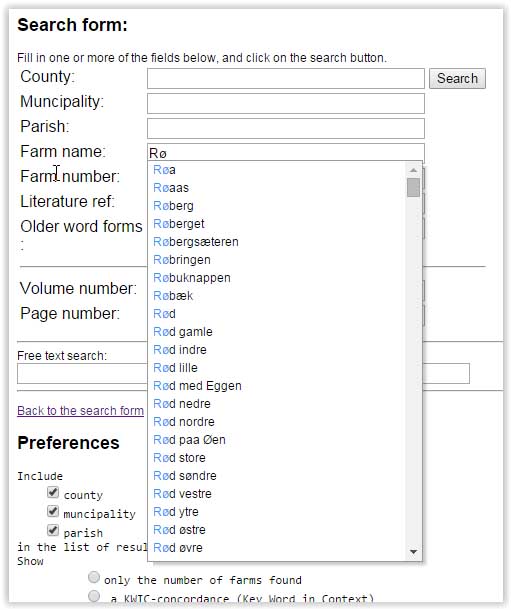
If you type in the name slowly letter by letter, a drop-down menu appear and show you how you are doing. This can be helpful if you are not certain about the spelling of the name. If the drop-down menu disappears before you are finished typing, the name is either misspelled or not included in this database. As the spelling of names has changed through time it can be smart to play a little with this drop-down menu as it can help you find names that are similar, and may turn out to be the one you are looking for.
The drop-down feature also works for the other search fields in the form.
Hitting “Search” will bring up a list of the farm/farms with the name you typed. The list will show you the farmnumber (second column), parish (third column), the municipality (fourth column) and finally the county/amt (fifth column). In the first column are boxes that you can check for the farm/farms you want to have a look at and hit “Show”.
Searching for names like Berg, Haug, and Li will give you a large number of hits, so you might want to print the entire list as a reference as you are working to narrow your search.
You should note that when you look at the farms in this resource you also get a list that shows how this particular farmname has been spelled at different times.’
Oluf Rygh’s “Norske Gaardnavne” – Norwegian Farmnames is not complete so when I don’t find what I am looking for there, I go to Se eiendom.
Norgeskart
Another good map is found at Norgeskart.no . Unfortunately the interface is only in Norwegian
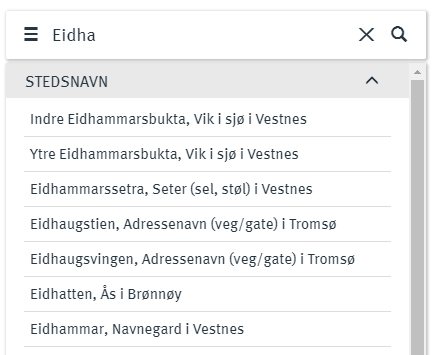
In the Seach field (SØK) we can enter letter by letter and get suggestions as we go.
When we have chosen a farm we get this menu. The two first items are the most interesting to us.
- See information about the property
- See facts about the name
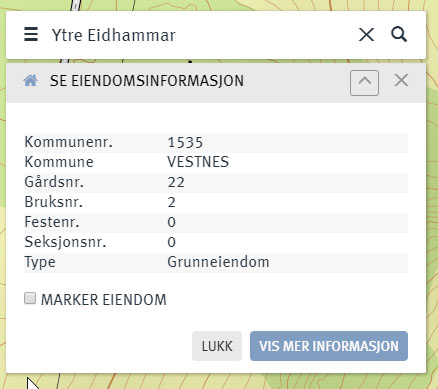 Choosing “See information about the property” give us this menu
Choosing “See information about the property” give us this menu
The translation of the first four items in this menu:
- Municipality number (in this case 1535)
- Municipality name
- Farm number
- Farmpart number
If we tick the box “MARKER EIENDOM” we can see the extent of the property on the map.
We can click “VIS MER INFORMASJON” → Show more information
This brings us to a “Faktaark” → Fact sheet

Much of the information in this fact sheet is the same as we saw in the first menu. We may, however, take a look in the lower left corner. I have put a ring around the name of the farm/farmpart. It can be wise to check this to see that we in fact are looking at the right farm. This is especially important when looking for a farmpart with a different name than the main farm.
Matrikkelutkastet 1950
The third source for finding Norwegian place names is “Matrikkelutkastet 1950”. This is a draft for a property register that was made in 1950.
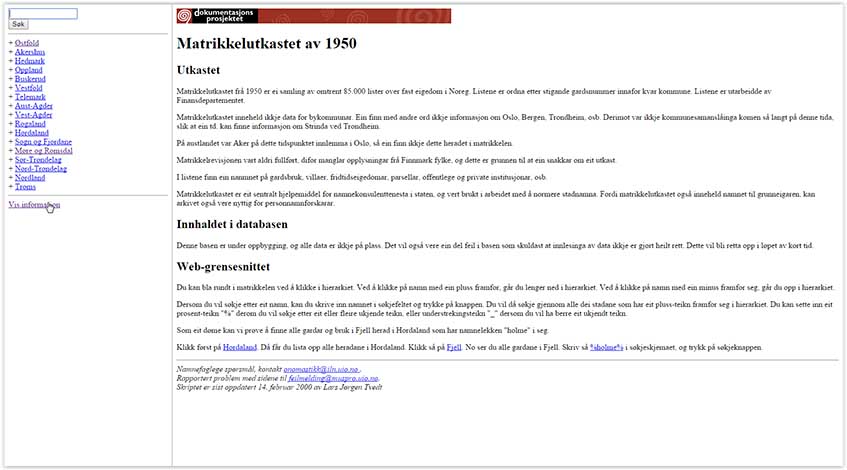
This is a list of about 85 000 properties in Norway. This list does only contain properties in the rural districts, so the towns are not included. The county of Finnmark is not included either. You should note that since 1950 many rural municipalities has been united with cities, so if the farm you are looking for today is within a city municipality it might not have been so in 1950.
The area we live in was part of the old Skjevik farm. We are today within the borders of the town Molde. In 1950 this area was part of the municipality of Bolsø, thus it is included in the “matrikkelutkast.
The interface is only in Norwegian, but it is fairly straight forward. If you know what farm you are looking for you can go through the menu choosing county, municipality and farm. You then get a list of the sub-divisions (bruk). In the list that appeare, the number on top (in bold) is the farm number (Gardsnummer) the numbers below is the sub-division number (bruksnummer).
You can use the search option, by typing in the name of the farm you are looking for. Note; the search engine searches within the choice you have made in the hierarchy on the left. If you have no idea where the property you search for are situated, make sure you are at the list if counties when you make your search. If you know what county you want to search, choose the county name before you make your choice. Likewise if you want to restrict your search to a municipality.
By using the %-signs you can search for places that contains the word you search for. If you type %vik% you will get a list of all the place names in Norway that contain the word “vik”. This gives you large number of results that can be time-consuming to go through. You might try to think of a letter that can be added to focus the search.
This was a little introduction to how you can search for place names. I have used both Oluf Rygh’s “Norske Gaardnavne” – Norwegian Farmnames, Se Eiendom and Matrikkelutkastet 1950 in my own genealogy research. I hope you find this information useful. Don’t hesitate to contact me if you have questions or comments on this topic. There may be things that should be added or things that needs clarification. Go to contact and send me a word.
The user-interface is in Norwegian, but it is quite self-explanatory.
For more information about Norwegian geography check out Former municiaplities in Norway

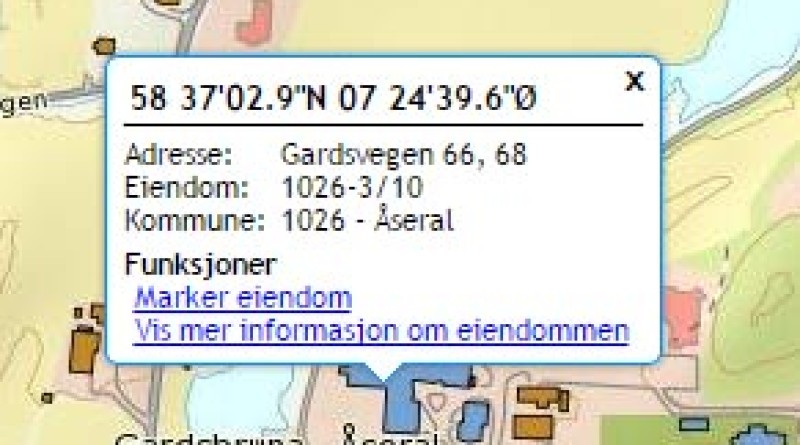
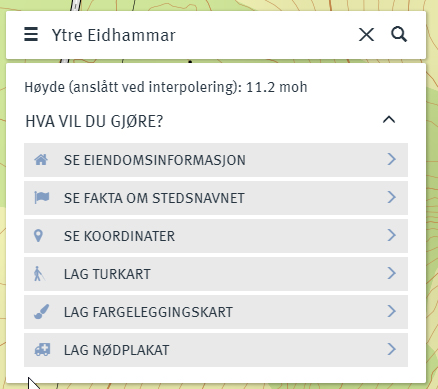

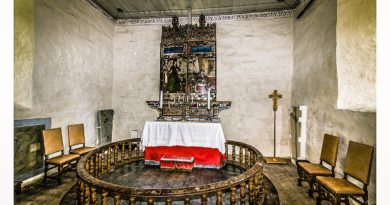


I had been using both the Norse Gaardnavne and the Matrikkelutkastet to verify the farm names for my Norwegian ancestors. I want to use the farm name at the time of birth as the surname, listed farm names from the censuses for timelines, but the current name for location of birth, confirmation, death, etc. Is it right that I would use the name listed on the Matrikkelutkastet. I had never heard of the Se Eiendom before now. Is the farm name and location the same on both of these? How much of the information from the Se Eiendom do you include in your genealogy?
One more question: I see that you use “christening” rather than “baptism”. Why is that? Thank you.
Hello Linda
Thanks for visiting my blog. The farm name on the “Se eiendom” and “matrikkelutkastet” may be written slightly different as the spelling of many of the names have changed over time. Maybe you find some usefull information in my article found here https://martinroe.com/blog/index.php/2016/10/25/how-i-record-norwegian-locations/
When it comes to baptism or christening I believe I have used both. English is not my native language and I thought both words expressed the same.
Your notes have been incredibly useful–adding great options to my search for proper place names. I’ve had luck finding the farm names for family in Rygh’s listing, but I’m not 100% sure how to read the data lists. I *think* they are chronological, but since my Norwegian is exceedingly limited (and google translate freaks out with place names), I’m not sure how to pick out the information I need. I wonder if you might take a short entry and annotate it, perhaps?
For example:
34. Lande. Udt. la`nne. ― a Lande DN. XII 22, 1328(trykt
efter Afskrift fra 17de Aarh.). [Lander (søndre) DN. XV 823, 1564
Lande (2 Gaarde) JN. 358].
Lande 1593. 1600. 1604.1/1, 1/1. 1626.
Lande søndre og nordre 1668. Lande søndre, nordre og øvre 1723
(den første med 2 Opsiddere).
What I see are two reference to external documents in 1328 and in 1564 (which describe transfer/sales of land). Then there is the list of what he farm name/composition was: the name of the farm remained Lande in 1593, 1600, 1604 and 1626, then farm parts split into north and south in 1667, and then in 1723 a third section was carved out (upper). Am I correct in my interpretation of the entry? I read your blog article on how farm names are actually formed (the farm-parts vs the overall farm and cottager names), so I want to be sure I understand how to pick out those details in the entry.
Thank you for the help!
Hello Robin
I believe you have interpreted this record correctly. The entry shows the different spellings of the farmname over time. Also, we get an impression of how this farm was split up. The reference “DN….” is a reference to a document colletion named “Diplomatarium Norvegicum”